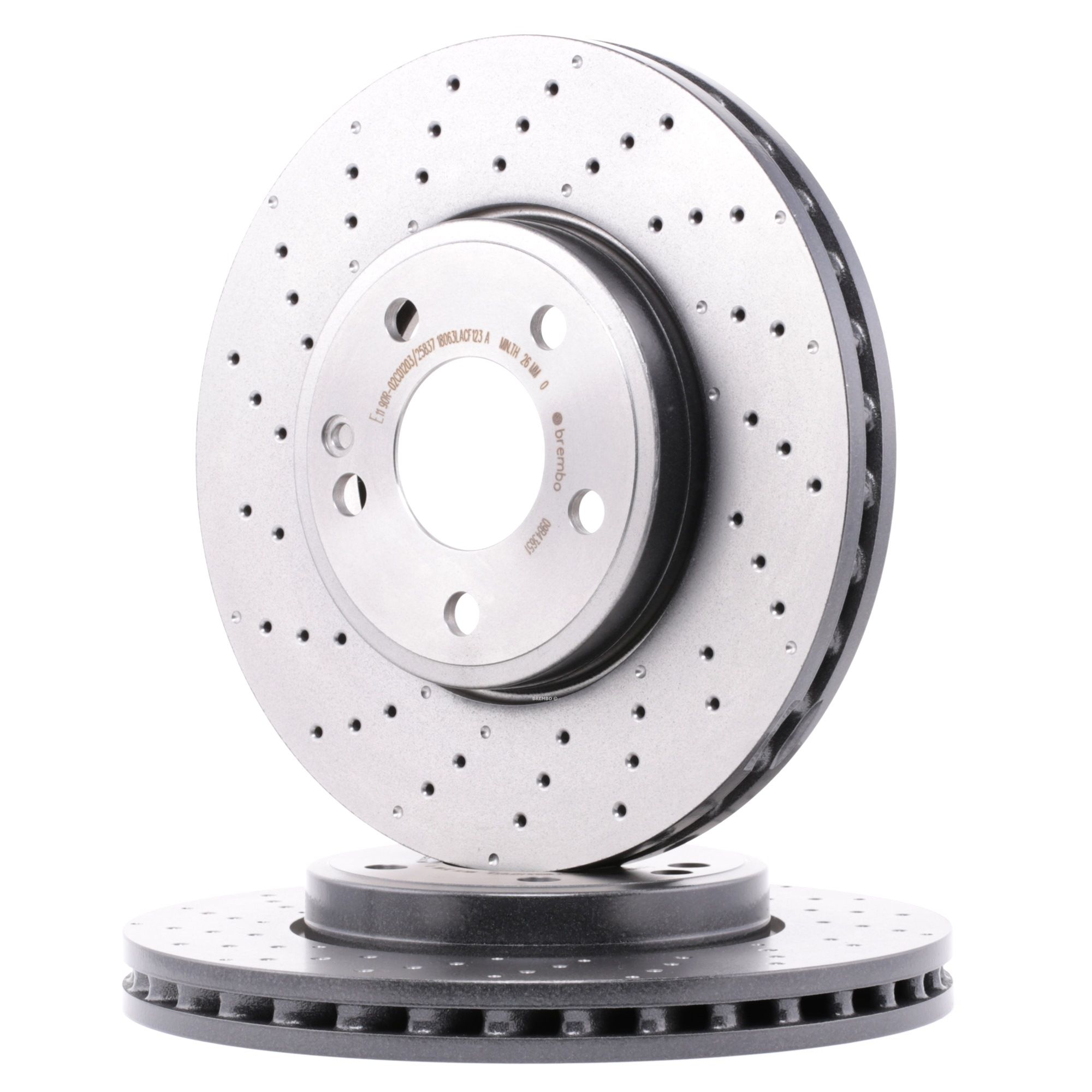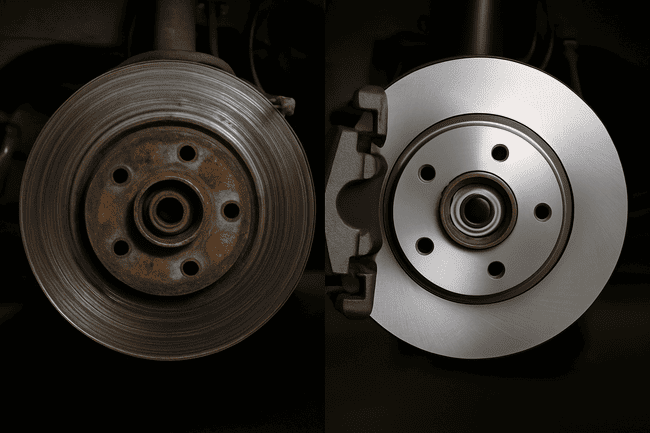Table of Contents
Brake Disc Replacement – How to Replace, Signs, When to Change and Cost in UK
Most drivers take for granted that their brake system is functioning properly. At the very latest, when the wear indicator signals that the rear and front brake pads have reached their limit, you should replace them.
After all, a well-functioning brake system is extremely important for your safety and for all occupants in the vehicle. This is why it’s necessary that you, or a mechanic, check the fluid, brake pads, and discs regularly.

How to replace a brake disc
The general steps for removing and installing brake discs are below, however, each vehicle model is different. For more in-depth instructions, refer to the vehicle repair manual. You’re advised to replace both brake discs on the axle at the same time, as well as the pads, to ensure even braking.
 BREMBO Brake disc
295x28mm, 5, perforated/vented
BREMBO Brake disc
295x28mm, 5, perforated/vented
 BREMBO Brake disc
355x32mm, 5, perforated/vented, two-part brake disc, Aluminium Brake Disc Hub
BREMBO Brake disc
355x32mm, 5, perforated/vented, two-part brake disc, Aluminium Brake Disc Hub
 BREMBO Brake disc
390x36mm, 5, internally vented, slotted/perforated, two-part brake disc, Aluminium Brake Disc Hub
BREMBO Brake disc
390x36mm, 5, internally vented, slotted/perforated, two-part brake disc, Aluminium Brake Disc Hub
 BREMBO Brake disc
249x10mm, 5, solid
BREMBO Brake disc
249x10mm, 5, solid
 BREMBO Brake disc
360x36mm, 5, perforated/vented
BREMBO Brake disc
360x36mm, 5, perforated/vented
Step-by-step instructions:
- Loosen the lug nuts on the wheel slightly while the car is on the ground and parked.
- Raise the vehicle using a jack and secure it with jack stands and wheel chocks (chock the opposite axle).
- Unscrew the wheel fasteners and remove the wheel to access the brake assembly.
- Unbolt the brake caliper (usually two bolts on the back) and carefully hang it with a wire or bungee cord. Attention: do not let it hang by the brake hose.
- Remove the brake pads if necessary to access the disc.
- Take off the old brake disc. If it's stuck, gently tap it with a rubber mallet.
- Clean the hub surface with a wire brush to remove rust and debris.
- Install the new brake disc, aligning it with the bolt holes or retaining screw if present.
- Reinstall the brake caliper and pads, tightening all bolts to the manufacturer’s torque specifications.
- Reattach the wheel, lower the car, and tighten the wheel nuts in a star pattern.
- Pump the brake pedal a few times before driving to seat the pads against the new disc.
What are the signs that brake discs need replacement?
A vibrating brake pedal or wheels, strange squealing noises, longer stopping distances, and illuminated ABS warning lights: these are all key signs that your brake discs may need replacing. In newer vehicles, it is now common for an indicator to light up in the dashboard when the brake wear limit has been reached, signalling to the driver to change the brake discs and pads. Anyone who ignores this is taking a great risk with unpredictable consequences.
In older cars that don’t have an electronic notification to tell you if the brakes need maintenance, you’ll probably first notice when the brake discs begin to make a loud sound. Normally, when the brake pad wear limit has been reached, a metal pin (acoustic wear indicator) scratches the brake disc and produces a loud screeching and squealing sound every time you brake.
You should not ignore this sound. It means that you need to change the brakes as soon as you can. In addition, reduced braking performance (longer stopping distances), a pulsating brake pedal, and swerving during emergency stops can be signs of wear. You should also not ignore small cracks or other brake disc damage. If the time has come to change your discs, we recommend that you take a look at the Brembo brake discs catalogue – here you are sure to find a suitable replacement at a reasonable price.

When should I replace the pads and discs?
The recommended replacement interval for most brake pads is usually between 30,000 to 60,000 miles, while brake discs may last 50,000 to 70,000 miles. How quickly the parts wear out depends on the particular vehicle, its age, the way you drive, and the conditions you usually drive in.
Corrosion caused by environmental conditions, such as moisture, humidity, and road salt, can also lead to damage and wear. If you have an older car, the pads generally need replacing sooner than the rear and front brake discs – some wear out after only 25,000 miles. However, it is still a good practice to replace the parts together.
 BREMBO Brake disc
355x32mm, 5, perforated/vented, two-part brake disc, Aluminium Brake Disc Hub
BREMBO Brake disc
355x32mm, 5, perforated/vented, two-part brake disc, Aluminium Brake Disc Hub

 BREMBO Brake disc
295x28mm, 5, perforated/vented
BREMBO Brake disc
295x28mm, 5, perforated/vented
 BREMBO Brake disc
288x25mm, 5, internally vented
BREMBO Brake disc
288x25mm, 5, internally vented
 ZIMMERMANN Brake disc
370x32mm, 6/5, 5x112, Vented, Perforated, two-part brake disc, floating brake disc, Aluminium Brake Disc Hub
ZIMMERMANN Brake disc
370x32mm, 6/5, 5x112, Vented, Perforated, two-part brake disc, floating brake disc, Aluminium Brake Disc Hub
How much does brake disc replacement cost in the UK?
Brake disc replacement in the UK typically costs between £150 and £400 per axle, depending on the specific axle, vehicle make and model, and whether both discs and pads are replaced at the same time. Premium vehicles, performance models, or cars with larger brake systems often fall on the higher end of the price range. The cost includes parts and labour, with parts usually accounting for about half of the total.
Replacing brake pads at the same time is strongly recommended and may increase the overall price slightly but improves safety and performance. Independent garages often offer lower rates than main dealerships, though labour rates can vary regionally. Always request a detailed quote before agreeing to the service.
How to change brake discs
Top products related to this topic:










